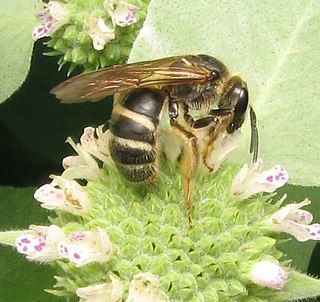
Halictidae is the second-largest family of bees with nearly 4,500 species. They are commonly called sweat bees, as they are often attracted to perspiration. Halictid species are an extremely diverse group that can vary greatly in appearance. These bees occur all over the world and are found on every continent except Antarctica. Usually dark-colored and often metallic, halictids are found in various sizes, colors and patterns. Several species are all or partly green and a few are red, purple, or blue. A number of them have yellow markings, especially the males, which commonly have yellow faces, a pattern widespread among the various families of bees. The family is one of many with short tongues and is best distinguished by the arcuate basal vein found on the wing. Females in this family tend to be larger than the males. They are the group for which the term 'eusocial' was first coined by entomologist, Suzanne Batra.

The sweat bee genus Lasioglossum is the largest of all bee genera, containing over 1800 species in numerous subgenera worldwide. They are highly variable in size, coloration, and sculpture; among the more unusual variants, some are cleptoparasites, some are nocturnal, and some are oligolectic. Most Lasioglossum species nest in the ground, but some nest in rotten logs.
Homalictus singhalensis, also known as Lasioglossum (Homalictus) singhalensis, is a species of bee in the genus Homalictus, of the family Halictidae. Sometimes, genus Homalictus is placed as a subgenus within the genus Lasioglossum.
Homalictus paradnanus, also known as Lasioglossum (Homalictus) paradnanus, is a species of bee in the genus Homalictus, of the family Halictidae. Sometimes, genus Homalictus is placed as a subgenus within the genus Lasioglossum.
Lasioglossum amblypygus, also known as the Lasioglossum (Ctenomia) amblypygus, is a species of bee in the genus Lasioglossum, of the family Halictidae.
Lasioglossum cire, also known as the Lasioglossum (Ctenomia) cire, is a species of bee in the genus Lasioglossum, of the family Halictidae.
Lasioglossum semisculptum, also known as the Lasioglossum (Ctenomia) semisculptum, is a species of bee in the genus Lasioglossum, of the family Halictidae.
Lasioglossum vagans, also known as the Lasioglossum (Ctenomia) vagans, is a species of bee in the family Halictidae.
Lasioglossum carinifrons, also known as the Lasioglossum (Evylaeus) carinifrons, is a species of bee in the genus Lasioglossum, of the family Halictidae.

Lasioglossum halictoides, also known as the Lasioglossum (Nesohalictus) halictoides, is a species of bee in the genus Lasioglossum, of the family Halictidae.
Lasioglossum serenum, also known as the Lasioglossum (Nesohalictus) serenum, is a species of bee in the genus Lasioglossum, of the family Halictidae.
Lasioglossum alphenum, also known as the Lasioglossum (Sudila) alphenum by Sakagami et al. (1996), is a species of bee in the genus Lasioglossum, of the family Halictidae.
Lasioglossum aulacophorum, also known as the Lasioglossum (Sudila) aulacophorum, is a species of bee in the genus Lasioglossum, of the family Halictidae.
Lasioglossum bidentatum, also known as the Lasioglossum (Sudila) bidentatum, is a species of bee in the genus Lasioglossum, of the family Halictidae. The species is mispellingly known as specific name bidendatum in some books.
Lasioglossum kandiense, also known as the Lasioglossum (Sudila) kandiense, is a species of bee in the family Halictidae.

Lasioglossum hemichalceum, which has sometimes been confused with L. erythrurum, is a sweat bee endemic to Australia. Large numbers of unrelated females will typically share a single nest, a behavior referred to as "communal". Nests are constructed underground by the independent efforts of the females. L. hemichalceum will typically begin creating new colonies during the summer, with brood production from late November through the first few months of spring. Members of this species do not demonstrate aggressive behavior towards one another. As the size of the colony increases, the reproductive potential of each female does not change, unlike many species of bees.

Lasioglossum sordidum, also referred to as the small native bee, is one of the smallest native bees found in New Zealand.

Homalictus is a subgenus of bees in the genus Lasioglossum subfamily Halictinae of the family Halictidae. They are found in Sri Lanka, Southeast Asia, east across the Pacific to the Mariana Islands, Samoa, Fiji and are most prevalent in Australia.





